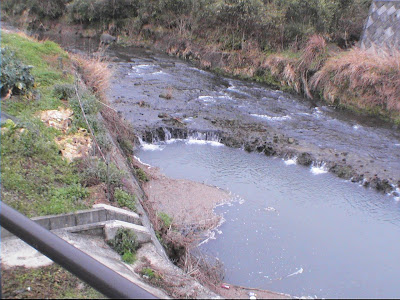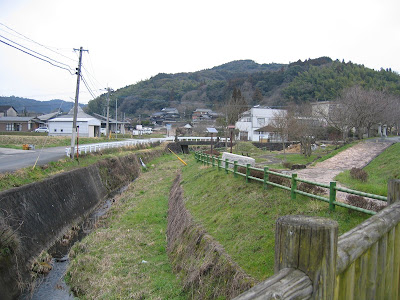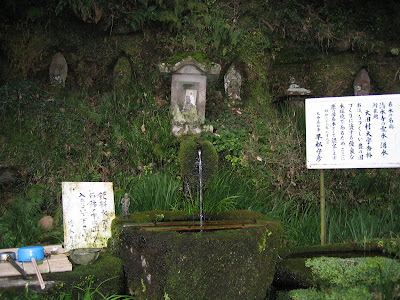Monday March 9, 2009
Ota is another city on the Kunisaki Peninsula.
I've not spent a lot of time in Ota, other than driving through it. There's not a lot in Ota that would give you reason to stop.
However I remember a JET friend once saying to me, "We went to pick so-and-so up in Ota-Mura, and, man, that place was so beautiful we couldn't believe it."
Although this was not my own opinion, the conviction with which these words were said managed to make an impression on my brain. Now whenever I think of Ota, I automatically remember how beautiful it's supposed to be. And whenever I drive through Ota, I keep my eyes peeled, waiting to be blown away by the beauty of it.
In my own humble opinion, Ota is beautiful only in the sense that all of Oita Prefecture is beautiful. I've yet to see anything in Ota that absolutely knocked my socks off, but every small town in Oita prefecture is filled with scenes of rivers winding their way between rice fields nestled in green mountain valleys, and Ota shares this charm as much as any other town. When the sun hits it just right on a beautiful spring day, it's something worth seeing. (Part of the reason why I'm making this little pilgrimage to every city in Oita Prefecture).
On the day I went to Ota, however, it was cloudy and overcast. The weather forecast the previous day had predicted rain, but by morning it had been down-graded to cloudy skies with only a 30% chance of rain. I decided to take the chance.
I drove into Ota , and made my first stop at the town hall to see if I could pick up some maps and tourist information.
I went into the lobby and started looking at the brochures.
Shortly after I entered, a man in a business suit walked up and tried to get through the automatic doors.
For whatever reason, the doors, which had worked perfectly fine for me, refused to open for him. He walked up to the doors, stood for a minute, walked back, walked up again, stomped his feet in front of the doors, and they still wouldn't open.
I must have still been a bit sleepy in the morning, because instead of helping him I just watched the whole thing, with my mind very slowly forming the proposition that maybe I should go over and try to trigger the doors from the other side.
But by the time I had thought of this, he was already prying the doors open with this hands and squeezing his body through sideways in the small opening he had made. He saw that I was watching him, and gave me a sheepish smile that said, "Well, isn't this the strangest thing?"
Again perhaps because I was half-asleep, the incident didn't really strike me as funny at the time. It was only later in the day when I was walking around that I would think back to it and chuckle softly to myself.
I exited the town hall (the automatic doors worked fine for me) and then I looked around me at what appeared to be downtown Ota. There was the town hall, a school across the street, a river flowing through, a gas station, and a post office, and that was it.
I've been to a lot of small little towns on this project, but so far Ota takes the cake. I didn't even see a single convenience store, which, in Japan, says a lot. (In Japan, there's always a convenience store). Nor did I find a supermarket during my wanderings. I have no idea where the people of Ota get their food.
Although it's since been absorbed into Kitsuki during the 2005 Town mergers, Ota used to be designated as "Ota-Mura", Mura meaning village, or the smallest possible classification for a Japanese town.
And Ota deserves that classification. There's just not a lot there.
I walked up and down the river for a while anyway.
I came across a group of stones labelled "Jizojisekiden". Since I couldn't read much of the Japanese sign, I have no idea what that means. The only thing I could decipher was the date, which was 1367.
Ota-Mura was an agricultural town, and I saw some people at work in the rice fields as I walked by. I also saw a couple of cows outside of one house.
This wasn't the first time I've seen cows in Japan, but it was rare enough that I thought it warranted a picture. Livestock in Japan, at least here in Oita, is pretty rare, probably just because they don't have the space to keep them. And you can see from this picture the bulls don't exactly have a ton of room in this enclosure.
I made my way up the hill a little bit to see another temple,
and then eventually I made my way back to my car.
The map I got from the city office indicated Yokodake park as the main attraction in Ota, so I headed out there.
Once I turned into Yokodake, I realized I had been here before. During the Oita JET Charity Bicycling trip my 3rd year we had stayed overnight in the lodge here.
I had, however, never fully explored the park at the time, so I went for a little walk around now. Yokotake Park is located on the top of a big hill with a nice view of the surrounding countryside.
I also saw a deer park there, something I don't remember from my previous trip.
For 100 yen, you could buy some deer treats and feed it to the deer through the fence. So I decided to give it a try.
For 100 yen, it was pretty good entertainment.
The deer didn't always share as nicely as one might hope. Whenever I would try and feed a deer, another one would come over and they would lock horns and try and push each other away. Occasionally they would let out a small bleating noise during this struggle, and I thought, "Hmm, I always wondered what sounds deer make."
After I tried my best to distribute the treats equally to all the deer, I moved down to see what else Yokotake had to offer. First I came upon a children's playground and jungle gym. I kept walking and came to a trail leading into the woods and a sign pointing for "hari no mimi"--which, with my limited Japanese, I think translates to "the ear of the needle". (Apparently Japanese expressions and English ones differ slightly in their wording).
I followed the trail down into the forest, and there was indeed a small natural tunnel in the rocks which was labelled "the ear of the needle."
The trail continued, till I got to an old shrine named yokodagongen. There sign explaining the history had fallen into disrepair and most of the letters were now washed away by the elements. I did, however, catch the Kanji figures for Miura Baien, my old friend from Aki town. He must have had some sort of connection in Ota-Mura as well.
I continued walking along the trail, passing some more statues (Shugyotaishi?).
Eventually, the trail took lead me in a circle back to the main road. From there, I saw another sign leading onto a new and different trail labelled Kyosekitankendo, and followed this one.
It led to a look out tower from which I could get a good view in all directions of Ota-Mura.
After I felt like I had thoroughly explored Yokodake Park, I got back in my care and drove on.
The map of Ota-Mura indicated some sort of peach tree grove called Sumomo-en, and there were also road signs pointing towards this. But after following several winding mountain roads that seemed to lead nowhere, I gave up on it.
I haded back towards the center of Ota Mura, and this time followed the road in the other direction.
There was a rest stop where I parked my car, across from Shirahigetawara shrine.
After climbing up the stairs and getting a look at the shrine, I decided to continue down walking the road. (It had a nice wide sidewalk that seemed to just invite me to walk down it. Plus, it followed a river.)
There was a few stone sculptures along the river bank, that I stopped to take photos of.
While I was taking these photos, I was close enough to the elementary school to hear the announcements come over the loud speaker. "Because of the rain today, we're not going to have recess outside. Everybody go to the gymnasium instead."
"The wimps," I thought, "It's not even raining out."
I followed the signs up the hill for Seisuiji (pure water temple?).
Seisuiji appeared to be a natural spring around which a temple had been built. The stone was carved so that the water seemed to be coming directly out of a lion's mouth. I'm not sure how old the place was, but it had an ancient feel to it. (But then again, maybe water just ages everything faster).
Water also collected in a small pond. While I was there, a crane flew up from the river below, and was about to land in the pond when it saw me standing behind the stone entrance. I must have startled it because it quickly flapped its wings to stop itself and then reversed direction in mid-air and flew back towards the river.
On the same hill as Seisuiji was Hodaji temple, which was a temple with a small pool of water at its base.
Just as I was looking at Hodaji, I felt it begin to rain. The school had been right after all.
I had left my umbrella back in the car, so I started heading back.
I usually try and avoid going out to the countryside on a rainy day, because, let's face it, when you're in the middle of nowhere in the Japanese countryside, there's not a lot of indoor activities.
That, and I'm not sure how waterproof my digital camera and video are, and I don't want to take any chances.
But there are no guarantees against the rain. Many times I've stayed in when the weather forecast was for rain, only to have sunny skies quietly mock me all day.
And sometimes, you get rain even when the forecast predicts clear skies.
The forecast for today was for cloudy weather with 30% chance of rain. I had decided to chance it, and I got the rain.
I read my book in my car for a while as I waited for the rain to let up. It never did. In fact it continued to rain steadily for the rest of the afternoon. It never quite reached the point of pouring, but it kept on steadily without much let up.
So, I resigned myself to sightseeing in the rain. I had a few plastic bags lying in the car, and I used those to wrap around my video camera to try and protect it from the rain. And I had an umbrella with me as well.
I drove up the road for a while to the "Zaizenbochi Stone Monument" and took some pictures there.
A little ways more down the road was another parking lot with tourist signs on it, so I stopped there. There was a small foot path leading from the road to the river, and then by the river there was a waterwheel.
A quaint countryside scene. But for some reason they had it all fenced off. I wasn't sure why this was, but no fence can stop me. So I climbed over the fence and went down to take a look at the water wheel and river.
Returning back to the main road, there, was a temple on the other side. It looked just like every other single temple I had seen that day, so I didn't take any new photographs. But I did walk up the steps and have a look around.
On the way back down I slipped and fell down the temple stairs. The rain had made the moss covered stone stairs all the more slippery, and my boots just came out from under me.
I skinned up my knee a bit, and bruised my rear end. But of course, what is really hurt in these instances is your pride. I immediately looked around to make sure no one had seen me. There were no cars going by the road at that point. There was another car in the parking lot, but the driver appeared to be taking a nap. I looked closely to see if he was watching me, and determined he was genuinely sleeping.
There were some houses nearby, so it's possible someone could have seen me, but for the most part I escaped a potentially embarrasing moment.
Next, I followed signs to the Tawara Family 5 storied Pagoda statue--a small stone pagoda that was indicated by tourist signs as something worth seeing.
There was a walking course around here as well, so, with my trusty umbrella, I did some walking back and forth and took a few pictures of Ota-Mura in the rain.
At 4:30 I called it a day and headed home. (Usually I try and stay till at least 5 on these excursions, but I made an exception because of the weather).
Ota Links:
Some pictures on a web photo album of the Ota sake festival and deer park. (pics of Bungo takeda are mixed in with Ota-Mura, but the labels help to sort out which is which). Upon closer examination, turns out I'm actually friends with the person who posted these pics. She was on Jet at the same time as me.
Another former Jet friend's description of Ota-Mura here: Ota-mura is literally a one-traffic light town. And it doesn’t even have a convenience store (in Japan, you know you are in the styx when there is no 24-hour convenience store nearby).
Ota is now part of Kitsuki city, due to the town mergers. So some of the pictures on the Kituski website are of Ota-Mura. Such as the Shrines, Buddhist temples and stone statues or Yokodake Natural Park.
Also this article: Project to Create Kyushu’s Only Doburoku (Festival) Land, to Carry on 1,300 Years of Gratitude
Link of the Day
Noam Chomsky speaking at Boston College: Feb 2009
Also
Iraq War Protest Planned for Saturday in Grand Rapids

































No comments:
Post a Comment